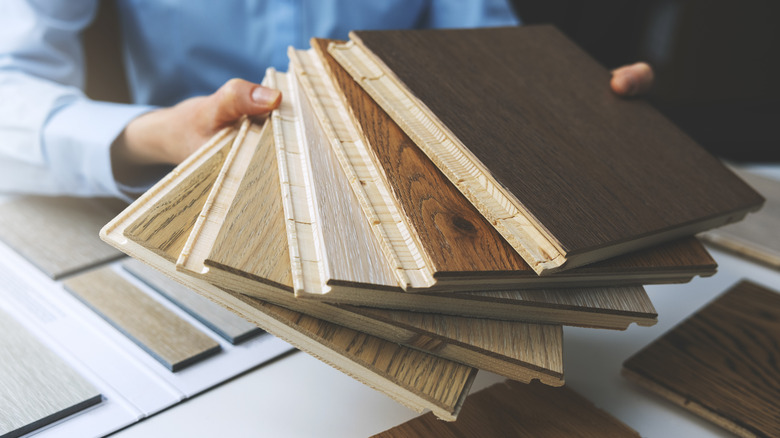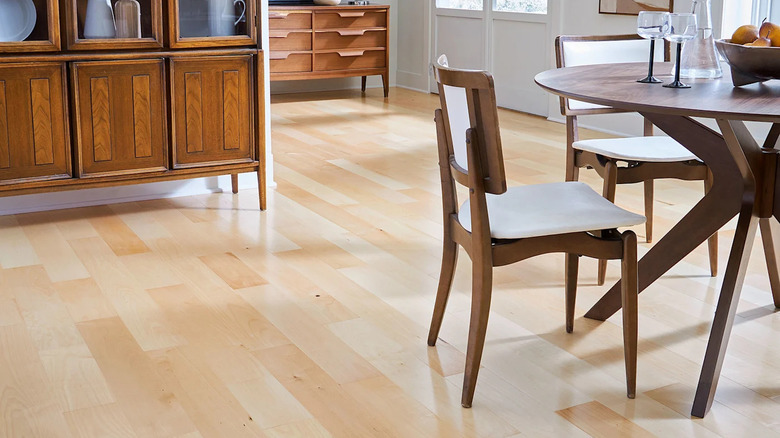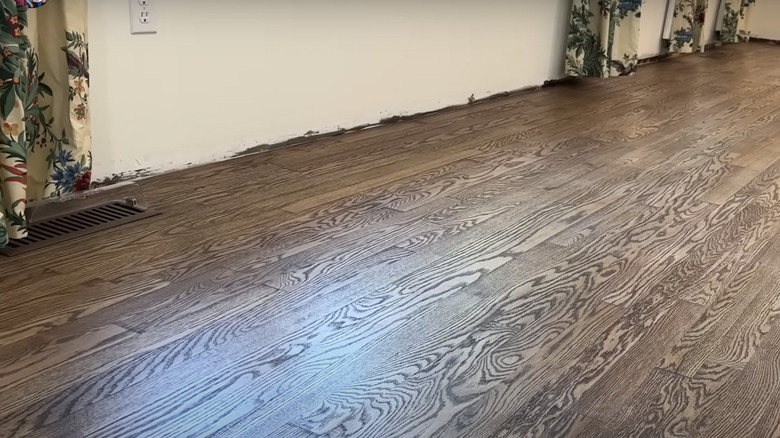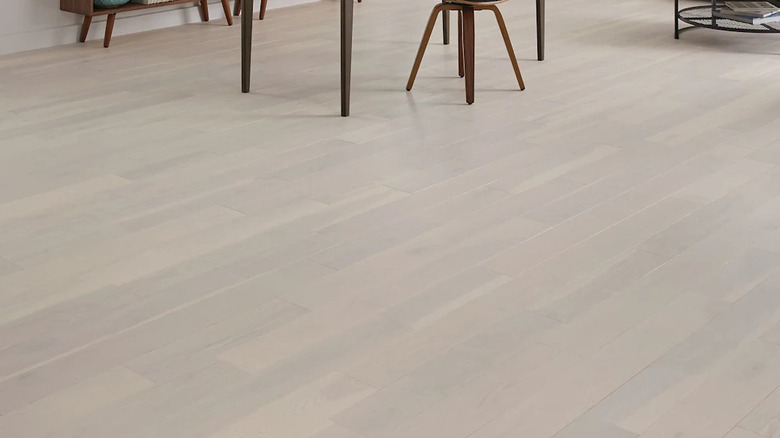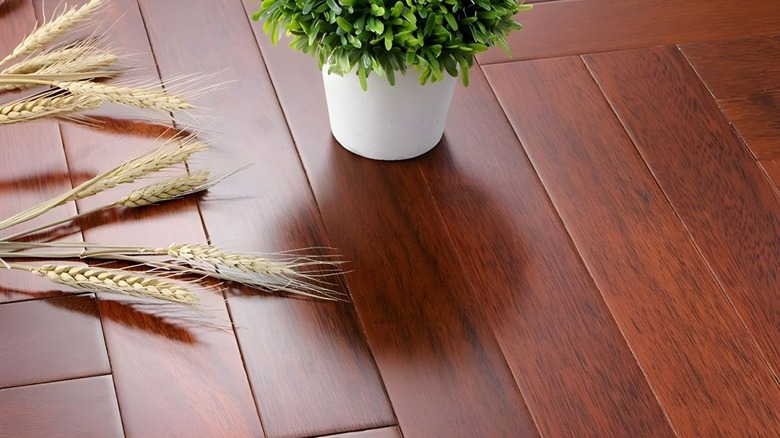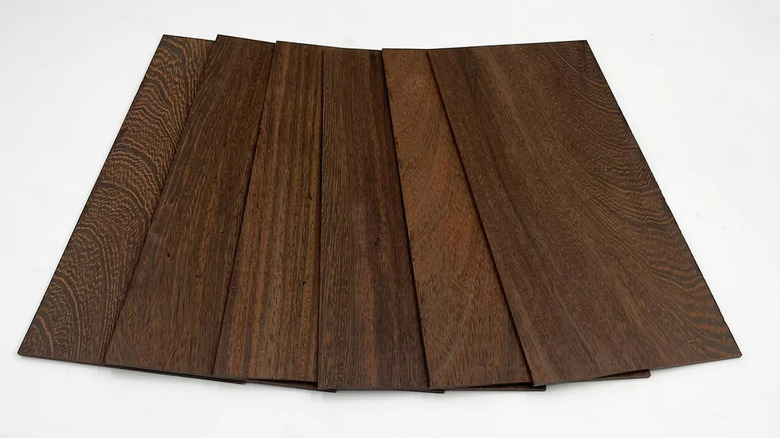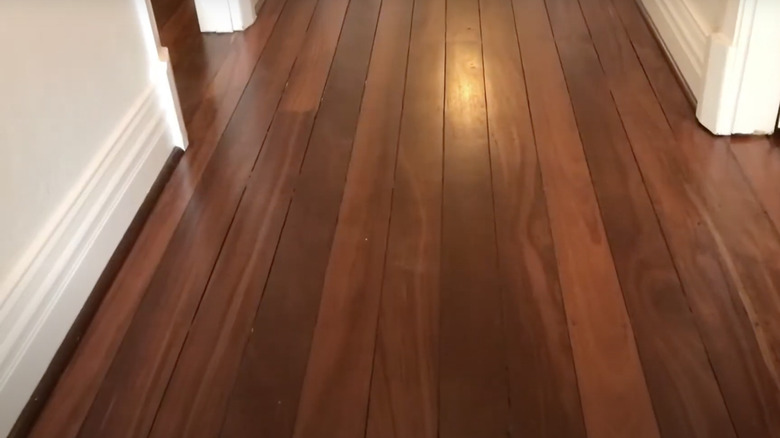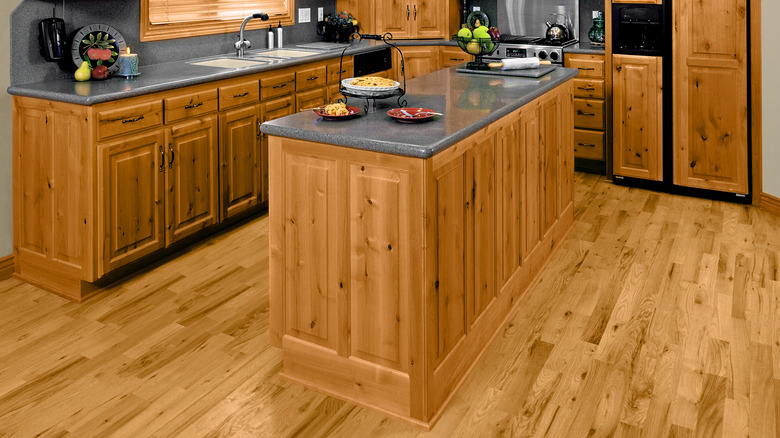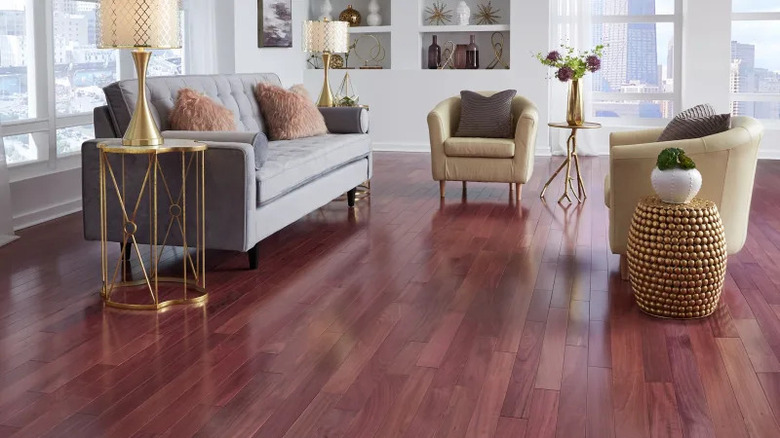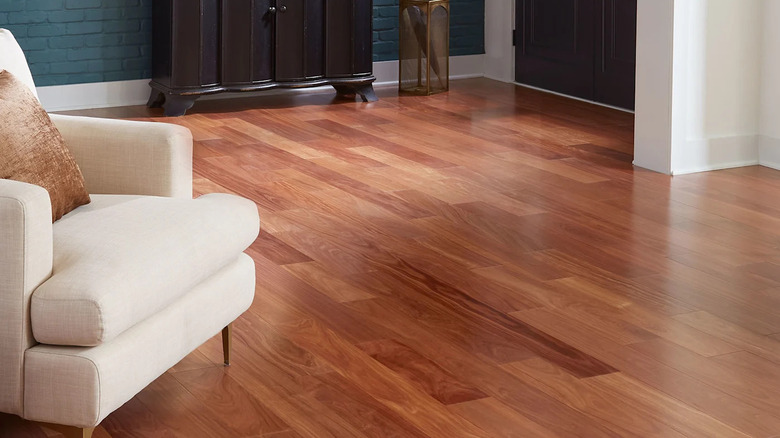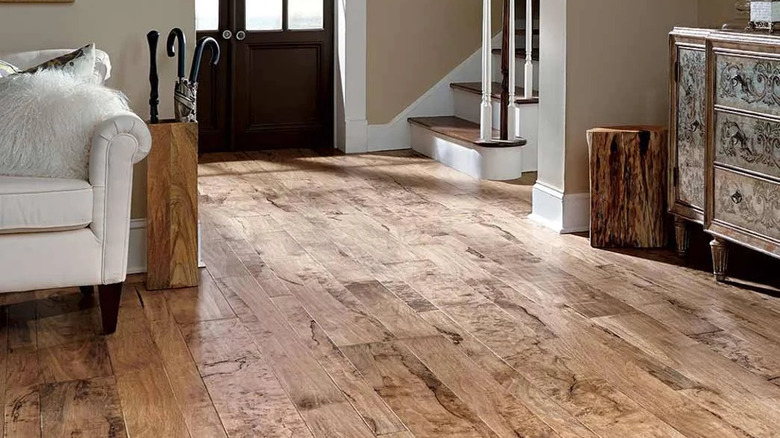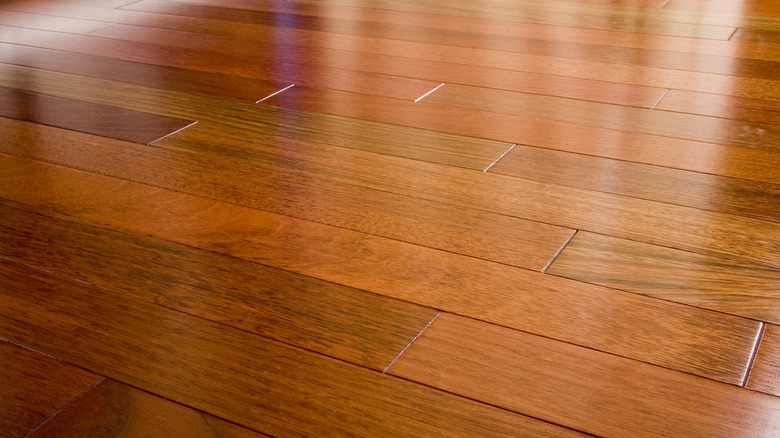The Longest-Lasting Hardwood Floors, Ranked
Hardwood flooring has been around for centuries. However, selecting a specific wood species for your home didn't become commonplace until more recent times. Between the 1600s and 1800s, most people used local timber from surrounding forests. They didn't have the options that are so easily accessible today, where you can choose just about any hardwood and have it manufactured and shipped as needed.
There are dozens of recognizable wood species, including oak, maple, ash, and more. To be considered a hardwood, these species must test at a 1,250 or higher numerical rating on the Janka Hardness Scale. This test measures wood's durability and strength by determining how much force it takes to push a steel ball halfway into the board. Every wood plank is a little different, even if they come from the same tree, so most species fall within a range on the scale.
Ultimately, the higher the range, the more reputable the hardwood. If installed, sealed, and finished correctly, it should hold up long term, even in a high-traffic home filled with adults, children, and pets. Below are 11 hardwood species, rated by the flooring industry from lowest to highest on the Janka Hardness Scale.
11. Hard (sugar) maple reigns over other maple species
Hard maple, often characterized as Sugar Maple, is tougher than other species within its plant genus. It has a hardness rating of about 1,450, and it sports pale white to yellow shades with hints of blue, red, and pink. With its physical appearance and composition combined, this wood is as undeniably brilliant as it is hardy.
While it's quite tough on its own, you can extend its lifespan considerably with a strong polyurethane finish. Poly-based coatings are common in bowling alleys and gyms, where maple flooring is used and subjected to high and consistent traffic. They are also occasionally used in residential settings.
Without the protective finish, maple is susceptible to scratches, especially if you have pets or rambunctious children at home. It's still tougher than softwood species rated under 1,250, but investing the additional $2 to $3 per square foot is highly recommended to ensure a maple façade is preserved. Depending on the grade or quality, prices start as low as $3 and hover around the $10 mark per board foot of lumber alone. Overall, hard maple is widely available, guaranteeing renovators have many brands to compare to find the best bang for their buck.
10. Multiple species of oak meet industry standards and come in an array of colors
Oak is often considered the industry standard of lumber since it's quantified at just above the 1,250 hardness rating. Many oak hardwood species range between 1,290 and 1,620, and white and red oak are the most commendable of their type. They both tend to rate higher on the scale, ensuring their dependability in your home long term.
Both white and red originate in North America, making them sustainable options in two ways. The oak harvest and production process is legally regulated, and lumber doesn't have to be transported far to be installed in local homes. Hauling any heavy material over long distances causes carbon emissions, but since oak forests exist all over the United States, it's much easier to find hardy options within a reasonable distance.
Red oak is slightly cheaper at as low as $8 per board foot, while white oak is slightly more expensive at $12-plus per board foot. White oak fetches a higher price because it's more resistant to rot and water damage. Their colorings match their namesakes, and many choose based on their intended interior design direction. How long these floors last depends on several factors: the installation process, origin and tree quality, and board thickness. Typically, the thicker the lumber, the longer it'll last.
9. White and blue ash are unique but have similarities to other species
White and blue ash trees are harvested throughout the eastern United States and nearby areas, favored for their beautiful shades and physical resilience. Blue ash takes on a cool tone, as the name implies, while white ash has a pale gold to deep tan coloring. White ash also has noticeable porous patterns, which often cause it to be mistaken as hickory or oak wood. Although some slabs are rated at around a 1,290 hardness rating, ash wood can go as high as 2,030, causing it to surpass oak wood in terms of firmness.
Both ash variations are naturally resistant to decay and rot, though white ash is better suited for outdoor installations than its counterpart. Blue ash is most reliable when coated in a protective finish to preserve its appearance. Since these trees are grown, harvested, and shipped within the United States, they are great options for those searching for durable, eco-friendly hardwood. These species are also very affordable compared to exotic woods found further down on this list, costing between $5 to $18 per board foot. Certain local hardwood manufacturers offer discounts for bulk orders, meaning a bigger project with thicker wood slabs may score you a better deal overall.
8. Merbau has extreme strength and stability
Merbau hardwood isn't as well known as some of the bigger names on this list, but that doesn't make it any less formidable. Often rated between 1,500 and 1,910 on the Janka Hardness Scale, Merbau comes in light to dark brown shades and is often tinged with orange when first cut. In addition to its heavy-duty composition, it resists rotting and insect infestations.
It's around $10 per board foot, making it very affordable as far as hardwood goes. However, you should consider this species is red-listed by the International Union for Conservation of Nature and Natural Resources (IUCN) as a "nearly threatened" species due to its dwindling population. The main issue is that consumer demand is taking lumber faster than this species can grow. It takes time for these trees to mature and produce the strong wood that people desire for their homes and businesses. Bearing this in mind, if you have your heart set on Merbau timber, consider using it for smaller spaces. You could also use it as a border or as accent pieces alongside other strong and sustainable hardwoods.
7. Wenge is a rich dark hardwood from central Africa
Wenge heartwood has a medium brown color with lighter-toned streaks throughout, and it differs from other hardwoods because it turns a lighter shade over time rather than darkening. At a 1,630 to 1,930 average hardness rating, it's unsurprising people flock to this wood for its evolving appearance and substantial sturdiness.
While it is a beautiful hardwood, sources warn that many of these trees are harvested and illegally logged. Keeping this in mind, be diligent in researching your product's origins, ensuring it's not taken from unethical locations. Most legal lumber suppliers list wenge at around $25 to over $30 per board foot, making it pricey if you use a reputable dealer. If you don't know where to start, search for products labeled with the "FSC" logo. This logo indicates that the Forest Stewardship Council has verified the logging practices to be legal and sustainable.
Properly harvested and installed wenge wood lasts 20 years or more with proper drying and an oiled finish. It's naturally resistant to many conditions that usually lead to wood deterioration, such as abrasion, rots, and burrowing insects. Since it repels these issues, it's more likely to last an extended period.
6. Jarrah is known for its rich coloring and unique graining
Jarrah wood is comparable to the infamous Brazilian cherry, which is lower on this list. It has the same rich reddish coloring that makes it stand out among less vibrant tans and browns. With around an 1,860 to 1,910 hardness rating, it considerably surpasses the requirements for being defined as hardwood. It's notably resistant to insects and decay throughout its lifespan, making it especially durable on top of its numerical rate.
This hardwood is harvested throughout Southwest Australia, where its prices are kept more mid-range. However, Jarrah is around $30 per board foot when exported as an exotic wood. It's also notable for being a sustainable option since it's not on the Convention on International Trade in Endangered Species of Wild Fauna and Flora's (CITES) endangered list or on the IUCN's threatened species list. In fact, it's primarily harvested from regrowth forests dedicated to supplying supple lumber without wiping out natural populations.
5. Pignut hickory is the hardiest of hickory species
All 12 hickory tree species sit above the minimum 1,250 hardness rating, but pignut hickory takes the cake at a whopping 1,820 to 2,140 valuation. It's rated 30% higher than the industry standard, and the flooring has a creamy white to light tan coloring that sets it apart from other wood options. It also requires very little maintenance and is water-resistant as far as wood goes, making it all the more practical for years of use. This also makes it more reliable in humid climates, where other hardwoods wouldn't hold up as well.
Costing only $5 per board foot, it's both strong and one of the most budget-friendly wood flooring choices out there. It fares better than many other wood species would in high-traffic areas. When sealed and finished, it's a great flooring for kitchens, foyers, living rooms, as well as hallways.
4. South American purpleheart is widely available
Purpleheart hardwood is also called "amaranth," and it looks as its name implies -– a deep brown and purple-hued color. Over time, this wood fades to a darker brown with a hint of indigo, always maintaining a bit of its vibrant coloration. Since it's harvested from many species, the hardness has a wide range, from 1,860 to 2,520. Even at its weakest (1,860), this wood is rated far above the standard hardwood requirements, proving its sturdiness and reliability.
This wood is highly affordable for its toughness rating, at about $15 to $22 per board foot. Another perk is that it is not commercially processed and is highly regulated by Panama and Costa Rica's laws. It isn't listed as a threatened species, and if you choose this wood for your floors, you can rest easy knowing you made a practical and ethical choice. Purpleheart varieties are often used for industrial construction, which also guarantees their long-term dependability as residential flooring.
3. Santos Mahogany is reasonably priced but has supreme durability
Santos mahogany wood planks range from a golden brown to a purplish tint that reddens with age, but the beautiful coloring isn't its most remarkable quality. This wood species is ranked extremely high at 2,200 to 2,400 on the Janka Hardness Scale, making it both consistent and incredibly tough. Ironically, this species isn't actually mahogany, as the name implies. Although it shares many aesthetic characteristics with mahogany trees, it is actually in the Fabaceae family with legumes, peas, and beans.
These wood planks fetch a mid-range price at about $15 per board foot. Hurst Hardwoods gives their pre-finished Santos mahogany lumber a 25-year warranty, so you can expect it to last at least two decades or longer with proper care. Like other hardwoods, you can extend the lifespan with proper maintenance and an aluminum oxide finish, which adds to the natural durability and offers additional scratch resistance.
2. Mesquite is a hardy North American wood that needs no finish
Mesquite planks aren't overwhelmingly popular as flooring, which is surprising given the unique knots, splits, worm holes, and bark pockets strewn throughout the tan to reddish-brown wood. Every piece of wood is distinctly rustic, with varying patterns that add character without diminishing reliability. The wood is as beautiful as it is hardy and is appraised between a 2,299 to 2,345 rating.
One of the more unique qualities of this wood is that it's incredibly resilient, even when the planks are left unfinished. Gapping, which is when the spaces between lumber planks spread apart over time, is nearly unheard of in mesquite wood. This makes it great for outdoor and indoor renovation projects, where it lasts for decades to a lifetime. The cost of about $20 per board foot is slightly above mid-range pricing but is a reasonable rate given the product's uniqueness and strength.
1. Opulent Brazilian cherry comes from the rainforests and lasts for decades
Brazilian cherry hardwood is the epitome of decadence, with its commendable rating and radiant color. Depending on where you import wood planks from, the hardness rating falls between 2,350 and 3,500, making it far beyond the minimum to be considered hardwood. The planks vary from purple-tinted reds to orange-hued browns, and they often have a cherry-red hue highly sought after by contractors and interior designers. The colors darken and become more refined with sunlight exposure and age, but the composition stays true to its strong initial form.
The initial darkening of the wood is most significant in the first 90 days of light exposure, but the wood continues to transition slowly forevermore. The appearance changes over the years, but durability does not. This wood is highly resistant to rot, fungus, and termites, and can last for two or more decades with proper care. In addition to its incredible rating, it's affordable at around $11 to $13 per board foot.
